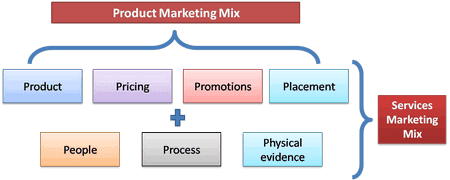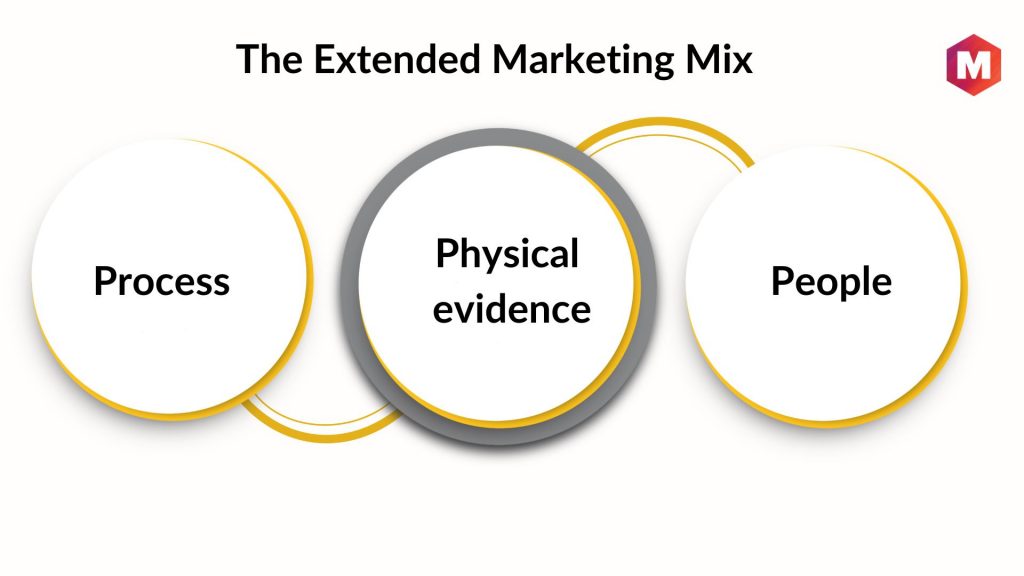The extended marketing mix, commonly known as the 7Ps, is a collection of seven marketing aspects designed to work together to achieve a marketing strategy’s objectives. The seven factors are product, price, positioning, promotion, people, process, and physical location. They create a complete marketing mix strategy to help you reach your target market more effectively.
The original marketing mix consisted of the four Ps: product, pricing, placement, and promotion. E. Jerome McCarthy introduced it in his 1960 book “Basic Marketing: A Managerial Approach” as a method for marketers to develop effective strategies. The extended marketing mix includes three more components: people, process, and physical space.
Table of Contents
What is the Extended Marketing Mix?

As the name suggests, the extended marketing mix is an extension of the traditional marketing mix for products. The 4Ps are also known as the product marketing mix. As services came more into the picture, it was seen that the 4Ps could not justify the marketing mix.
Three more elements were necessary to explain the marketing of services. When products began offering services, the extended marketing mix also started applying to products (like Maruti service stations, where Maruti is a product and the service station is a service). These elements were added to the marketing mix to form the extended marketing mix.
In the above figure, the first four Ps are the product marketing mix, and the next three Ps are added to make the extended marketing mix, also known as the service marketing mix.
The four ps mainly constituted the following elements –
1. Product
2. Price
3. Place
4. Promotions
The extended Marketing mix was brought forward by adding the following three elements –
5. Process
6. Physical evidence
7. People.
- People refer to customer service representatives, store clerks, etc., who interact with customers and give them an impression of the company they’re buying from.
- Processes refer to the steps taken to get a product or service from the company to the customer, such as delivery services or online ordering systems.
- Lastly, Physical Evidence is the product a customer receives or what they expect from a service. This includes anything tangible, like packaging and customer service materials.
The same is explained below, taking restaurants as a service example.
Process
How can you execute things flawlessly and create a process that meets client expectations? That is the sole function of the process element. Let us say you were in a restaurant. So, how many tables will be there? Will you serve alcohol? If yes, how many servers are required? What is the number of tables per cook? Or how many dishes should be divided between the cooks? Thus, settling on a procedure that makes operations more accessible and faster is integral to the expanded marketing mix.
To make the process easier, a service blueprint can be created depicting how the entire process will unfold, from the client entering the restaurant to the customer leaving the restaurant and cleaning his table. The restaurant manager is responsible for ensuring the service plan is strictly followed.
Physical evidence
Physical evidence refers to the tangible physical features you add to an otherwise intangible product to set yourself or your service apart from competitors. So, in the previous restaurant example, the restaurant can be kept as simple as possible by using only the minimal necessities and hiring the fewest number of staff. Or it may be a high-end restaurant where, if you serve alcohol, you can keep a bar, add decent lighting and ambiance, play some good music, serve exotic dishes, use excellent silverware, and so on. Consider the difference in ambiance between McDonald’s and Pizza Hut, as McDonald’s is more of a budget fast food chain than Pizza Hut.
People
It’s the most significant component of the overall marketing mix. People, or the fifth P, are now included in the product and service marketing mix. Managers understand that a firm can only function with people in the correct positions.
Consider your favorite restaurant and the staff who serve you there. One restaurant may have a good cook who prepares wonderful and delectable dishes, while another may have an ordinary cook who produces average food. Which restaurant will you visit? Your favorite restaurant will likely have a cook and serve servers you adore and only give your orders. As a result, hiring the appropriate individuals can significantly improve your company’s performance.
The expanded marketing mix may be applied to products and services because process, people, and physical evidence are increasingly crucial in defining a company’s marketing mix.
Why is the extended marketing mix useful?
The adaptable structure of the expanded marketing mix offers an informative approach to marketing strategy. Each component includes a variety of consideration criteria, allowing marketers to create plans that address both company goals and consumer wants. Here are some benefits of using this “seven-pillar” concept:
Boosting Decision-Making Ability
The seven marketing mix components offer a thorough understanding of marketing aesthetics from a commercial standpoint. This understanding facilitates the evaluation of many factors that influence client selections and the calculation of connected organizational expenses. With a greater understanding of the overall mechanism, marketers may make more informed decisions that improve the effectiveness of their marketing initiatives.
Formulating a Comprehensive Marketing Strategy
Businesses can develop an effective marketing plan by considering the numerous aspects influencing client purchasing decisions. The seven elements promote awareness of multiple consumer pain spots, guaranteeing that marketing strategies provide the best returns for firms. Such a complete strategy enables marketers to consider customer views, resulting in an effective marketing design.
Setting Precise Marketing Budgets
Each of the seven pillars provides a unique perspective on the marketing strategy, which aids in cost determination for each area. This helps marketers to create a cost hierarchy, which results in a more resource-efficient marketing plan. Furthermore, it aids in determining whether some components require additional investment to ensure good outcomes.
Identifying Product-Market Compatibility
The seven factors help businesses develop a complete method for determining whether a product will work in the market by focusing on the triangle of people, price, and product. This helps them determine how useful and how much money a product could make them. The useful information gathered during this process can be used to make accurate budget plans for marketing and production.
Improving Data Quality
The broader marketing mix gives companies more ways to obtain customer information. By focusing on individual pillar interactions with customers, businesses can see customer trends and change their supply chain and processes to fit them. This focus on data methods makes marketing much more effective.
Comprehending Customer Needs
The marketing mix’s sales and customer service parts give you essential information about what your customers want. The interactions that happen through these platforms help generate leads and increase sales. They also learn to understand different customers’ feelings, which makes it easier to address their concerns through certain goods or services. This then leads to happier customers and more growth and profit margins for the business.
Extended marketing Mix vs Marketing Mix
When creating the perfect marketing mix, you need to be aware of two concepts: a marketing mix and an extended mix. A marketing mix includes four pillars or elements of marketing, such as product, pricing, promotions, and placement. In contrast, an extended mix includes seven elements, such as those of the traditional marketing mix plus people, process, and physical evidence.
When developing a complete marketing plan, consider the extended marketing mix. This includes looking at all aspects of your product or service. Let’s have a look at the role of marketing mix first –
- Product: This is the physical product you are selling or the service you provide. It’s important to consider features, design, quality, and other factors influencing the customer’s choice.
- Pricing: When it comes to pricing, you need to consider how much your target audience is willing to pay and what pricing strategy to use. Many options are available, such as economy pricing, value-based pricing, price skimming, etc.
- Promotions: Promotions refer to the promotional materials and sales promotions you use to market and promote your product or service. These could include anything from digital marketing and public relations to content marketing and physical promotional materials.
- Placement: Finally, you must consider where your product or service will be available. This is important as it needs to be easily accessible to your target audience.
Let’s now move on to the extended marketing mixes, which include all of the above elements plus people, processes, and physical evidence.
- People: The people element refers to the customer experience. It would help if you considered how your customers will interact with your product or service and ensure you offer a good customer experience.
- Processes: Processes refer to the methods you use when developing and marketing your products or services. This includes things like production and order processes.
- Physical Evidence: Physical evidence refers to the tangible physical elements of your product or service, such as packaging, advertising materials, and even the stores that carry your products or services.
By considering all these elements, you can create a complete marketing plan tailored to your target audience and give you the best results. With a well-crafted marketing mix, you can create promotional strategies that will help you meet customer expectations and reach your desired goals.
Conclusion
Looking into the 7 Ps and how they apply to your business plan can help you develop strategic marketing actions that meet the wants of a wide range of customers in your target audience. You can control these factors, which are affected by your internal and external business environment, to make the company money.
The marketing mix theory is still valid, but business owners need to adapt to changes in communication and technology. Marketers should devise creative ways to combine the marketing mix with new marketing platforms like social media, and they should keep changing it to meet customers’ needs in a constantly evolving setting.
Liked this post? Check out the complete series on Marketing

How do i relate the 7 ps to the generational theory